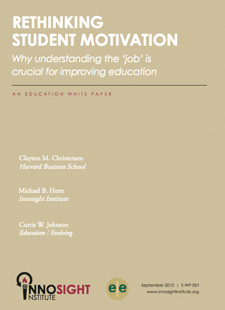Report • September 2010 • By Curtis Johnson, Clayton Christensen, Michael Horn
Why understanding the ‘job’ is crucial for improving education
This white paper is adapted from a new chapter in the second edition of Disrupting Class: How Disruptive Innovation Will Change the Way the World Learns (McGraw-Hill, September 2010) by Clayton M. Christensen, Michael B. Horn, and Curtis W. Johnson.
In most school reform efforts the focus is on the schools. The question we typically ask is, “Why aren’t schools performing as they should?” Perhaps a key reason we’re so dissatisfied with the state of public K-12 education is that we’ve been asking the wrong question. If we asked instead, “Why aren’t students learning?” perhaps we might see things that others have yet to perceive. After all, it’s the children’s performance that should concern us. The performance of a school is little more than the sum of the performance of its students.
In Disrupting Class we explained that prosperity is a bittersweet reward. Poverty often serves as an extrinsic motivator for some students, as it causes them to endure monolithic, batch teaching of subjects like math and science. When prosperity has removed this source of motivation, the solution must be to make learning intrinsically motivating. Student-centric learning will play a key role in addressing this challenge. The purpose of this paper is to draw upon another model from our research on innovation to dive more deeply into students’ motivation to learn. If children are motivated to learn and if we enable each one to learn effectively, we will have an education system with a great performance record. As the late educator Jack Frymier often said, “If the kids want to learn, we couldn’t stop ’em. If they don’t, we can’t make ’em.”
